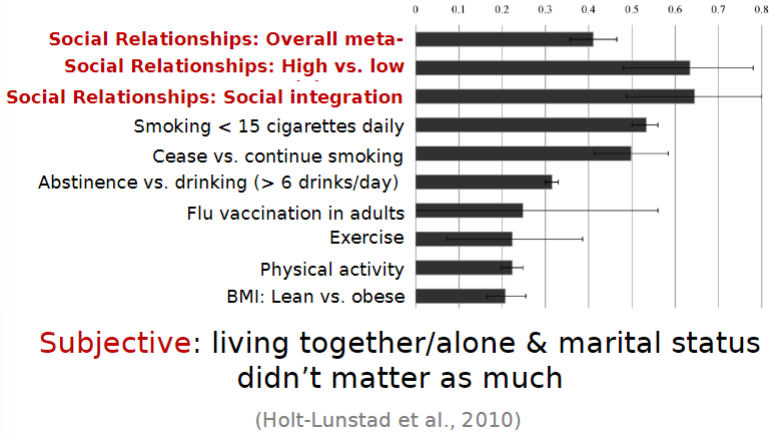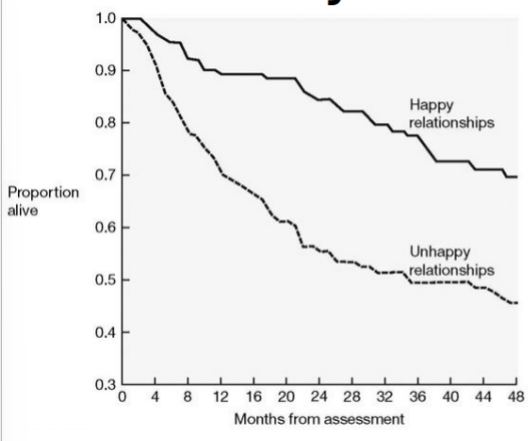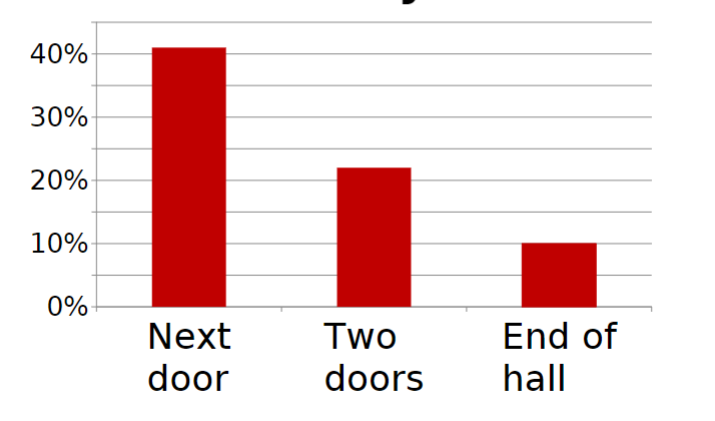social interaction 1: social affiliation & attraction
1/21
There's no tags or description
Looks like no tags are added yet.
Name | Mastery | Learn | Test | Matching | Spaced |
|---|
No study sessions yet.
22 Terms
what is ‘the need to belong’ according to Baumeister & Leary (1995)?
“human beings have a fundamental need to form and maintain a minimum quantity of lasting, positive and significant interpersonal relationships”
“we need relationships to survive and thrive”
what is the evolutionary perspective on ‘the need to belong’?
early humans lived in small groups surrounded by a difficult environment
adapted to be social and caring - more likely to survive, mature and reproduce
species evolved and became characterised by people who were close to others, caring and sought acceptance
evidence of a fundamental need to belong/need for social connection
social bonds are easy to form and difficult to break
without relationships we suffer
the need to belong can be satiated
the need to belong is universal
evidence that social bonds are easy to form and difficult to break
babies instantly form attachments
experience difficulty ending relationships
evidence that humans suffer without relationships
rejection causes pain, reduced wellbeing and reduced intellectual functioning
lack of a social network is a strong predictor of illness and mortality

describe the study by Coyne et al (2001)
after having a heart attack, people in happy vs unhappy relationships were later assessed to see if they were still alive

evidence that the need to belong can be satiated
we have a limited number of friends; ~ 6 friends in college
people spend less time with friends when in a romantic relationship
evidence that the need to belong is universal
reviewed evidence does not seem to be culture specific
suggests that belonging is a basic need that is shared worldwide
how does relationship quality affect wellbeing?
relationship quality promotes surviving and thriving
pleasant daily social interactions associated with greater life satisfaction
top 10% happiest people are highly social and have the strongest, most satisfying and fulfilling relationships (Diener & Seligman, 2002)
evidence of positive effects of weak ties on wellbeing
participants instructed to engage with barista (vs efficient interaction) and felt happier due to greater sense of belonging (Sandstrom & Dunn, 2014)
participants that were instructed to engage with bus driver (vs no instruction) felt happier (Gunaydin et al., 2021)
why can weak ties improve happiness?
positive interactions help us to recognise the value of others and feel connected
others typically feel happy and respond positively
in what ways do people underestimate the effects of weak ties?
underestimate:
how happy a target will feel
how much people like us after a conversation
positive effects of our kind acts and expressions of gratitude
what is relational diveristy?
“the richness and evenness of relationship types across one’s social interactions”
what is attraction?
evaluating another person positively (not just romantically)
we are often attracted to people whose presence is rewarding
what are the forces that attract?
reciprocity
similarity
familiarity (proximity)
what is reciprocity?
we like people who like us
we like others more after knowing they like us
we like other more if they like us specifically, not just everyone
what is similarity?
the way in which we tend to like people who are like us, especially when they have similar backgrounds (age, race, education, etc.), interests, and share attitudes and values
why do we prefer people who are similar to us?
trust others more when they are similar
we feel assured others will like us and enjoy spending time with similar others
what affects the effect of similarity?
similarity doesn’t really matter as it is actual personality traits that make people more likeable
perceived similarity makes people more like each other than actual similarity

what is familiarity (proximity)?
the people who, by chance, you see and interact with the most (more familiar) are most likely to become friends or romantic partners
describe the MIT housing study
students randomly assigned to 17 different housing complexes knowing almost no one beforehand
asked to list their 3 closest friends (after a few months)
65% of residents had at least one friend who lived in their own building (should only be 5% if proximity doesn’t matter)

how does familiarity work?
we have an increased opportunity to meet people who live close to us
we tend to like things more after we have been repeatedly exposed to them and they become more familiar to us (exposure effect)